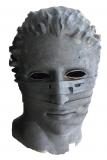Results 31 to 40 of 41
-
03-19-2014, 08:18 PM #31
You should be. That looks really nice. And is the adhesion really good between colors? That's my only worry. That's a great looking part.
I see you are using the ABS slurry (or whatever they are calling it lately) on the glass. I've started that and it works well. I had previously been using Aquanet and was having corner lift issues.Bambu P1S/AMS
NVision4D http://nvision4d.com
-
03-19-2014, 08:25 PM #32
Tough to say on the adhesion between colors on this part as its 4 .3mm layers high. Ill do a taller print with color change. But IMO it should not be a problem.
-
03-19-2014, 08:29 PM #33
Yea its ABS juice I shifted the glass trying to remove the part with a razor scraper it stuck that well.
-
03-20-2014, 02:11 PM #34
-
03-31-2014, 02:19 PM #35
OK, as it turns out, this has been documented at length and quite well by the all powerful rerap team in the second issue of their magazine.
http://reprapmagazine.com/issues/2/index.html
-
04-09-2014, 04:05 PM #36
And also this guy made a tutorial for you if you wanna try.
http://hydraraptor.blogspot.pt/2014/...ing-holes.html
-
04-14-2015, 11:41 PM #37Student

- Join Date
- Apr 2015
- Posts
- 7
Sorry to resurrect an old thread, but what about embedding wire into 3D prints for added strength, anyone ever tried this?
Very thin steel or Kanthal wire (I'm thinking 28ga or less) could add a lot of strength to some parts. It wouldn't work for everything - but for reinforcement around screw holes or hinges, for example, it could make a huge difference.
For example this bearing mount below (and sorry for the poor quality I did this in MSPaint). One strand of 28ga Kanthal added halfway through the print (red line), or even better, two strands (at 1/3 and 2/3 layer height) would add tremendous strength to this part. You could probably print the bearing housing way thinner and still have similar strength

Last edited by Mortimer452; 04-14-2015 at 11:50 PM.
-
04-15-2015, 05:35 AM #38
how are intending to embed the wire into flat infill ?
If you just lay the wire on the print surface and continue printing the print heads will hit the wire and knock it off.
You'd need two models. one with the channel for the wire and the other printed directly on top to continue the overall construction of the model.
Admittedly a thick enough piece of metal would add strength, but not sure a piece of wire would necessarily make much practical difference.
-
04-15-2015, 07:14 AM #39
While the idea does have merit in my opinion, the quality of the trade off might be difficult to evaluate.
What I mean is that : if the flange is too small, you'll get 1 or 2 internal shells, 1 or 2 external shells and two non infilled gaps in between. You won't have sufficient gap for an infill between the dark green and light green and the 2 won't be bonded either.
Sans titre.jpg
Don't think I'm not interested : I'll definitely try it. And we know it can be done : there was an article about that in 3DP recently. They used it to do flexible shapes with deformation memory.Last edited by LambdaFF; 04-15-2015 at 07:23 AM.
-
04-15-2015, 01:39 PM #40Student

- Join Date
- Apr 2015
- Posts
- 7
Good question, and the reason why I brought it up

28-32ga wire is pretty thin, less than the height of a layer if you printed at 300µ. I was thinking something more like adding a pause command at the layer you want to add the wire, quickly add it (maybe even heat the wire so it can "sink in" to the layer a little bit), then continue printing right over it, no channel required.
I have a roll of 28ga Kanthal wire on my desk right now. I wrapped a piece around a couple pieces of pipe and pulled it apart with maybe 20lbs of force. It's not a super-material or anything, but certainly much stronger than a strand of 300µ PLA





 Reply With Quote
Reply With Quote







Extruder not feeding during print,...
Yesterday, 02:02 PM in Tips, Tricks and Tech Help